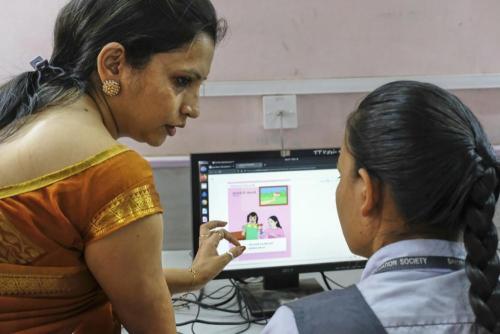How can countries begin to address the global teaching crisis? GPE’s ongoing blog series highlights several strategies echoed in the Teacher Task Force global report on the status of teachers: raise teacher salaries, enhance the profession’s status, improve working conditions, overhaul in-service preparation programs, support alternative certification routes and invest in continuous professional development.
These approaches aim to close the gap in both the number of teachers and the quality of teaching worldwide.
However, such measures require long-term planning and funding, and their benefits may take years to accrue. In the meantime, there’s another tool we can leverage to help address quantity and quality issues at the heart of the global teaching crisis: technology.
While it is no substitute for a sustained commitment to recruit, develop and retain excellent teachers, well-designed technology initiatives—managed and implemented by qualified and caring educators—can significantly enhance educational opportunities for both teachers and students.
This blog offers 3 such examples.
1. Technology can expand access to quality education
Every region across the globe faces teacher shortages, especially in sub-Saharan Africa and Southern Asia where there is rapid population growth. Technology can connect students who lack teachers so that they can continue their education.
Where robust internet access exists, virtual classes can provide instruction to students lacking qualified teachers, especially in STEM (science, technology, engineering, and math) subjects.
Online learning platforms, such as the National Education Equity Lab, offer underserved students access to a greater pool of educators and diversity in subject choices.
Online human tutors and, increasingly, artificial intelligence (AI) tutors can bridge gaps in subject expertise, providing flexible and personalized learning opportunities to students.
Where internet infrastructure is less prevalent or reliable, instructional television (ITV) is often the delivery mechanism of choice. Brazil’s Amazonas region (an area the size of France), Egypt, Ghana, México, Pakistan and Turkey currently use ITV to provide access to schooling.
With ITV, a trained teacher delivers a lesson via satellite TV from a television studio, either live or pre-recorded, to a group of students in a school or community center. Lessons are aligned to the curriculum, shared in small increments (15–30 minutes) throughout the school day and are typically followed by in-class small-group and individual work, questions and answers or discussion.
2. Technology can compensate for variable teaching quality
Many teachers struggle with basic content knowledge, communicating in the language of instruction and using effective instructional techniques. Well-designed technology initiatives can link students to high-quality instruction, driving improvements in literacy, numeracy and foundational skills.
Experimental studies in Ghana, México, Pakistan, and Zanzibar have highlighted technology’s ability to reduce the ill effects of low-quality teaching. Computer-aided instruction and educational apps have counterbalanced inferior quality instruction, standardized quality instruction and ensured students’ educational attainment in foundational skills.
Educational tools that make use of artificial intelligence can assist untrained teachers, volunteer teachers or teachers teaching outside their content area with planning lessons, designing assessments and developing learning materials.










